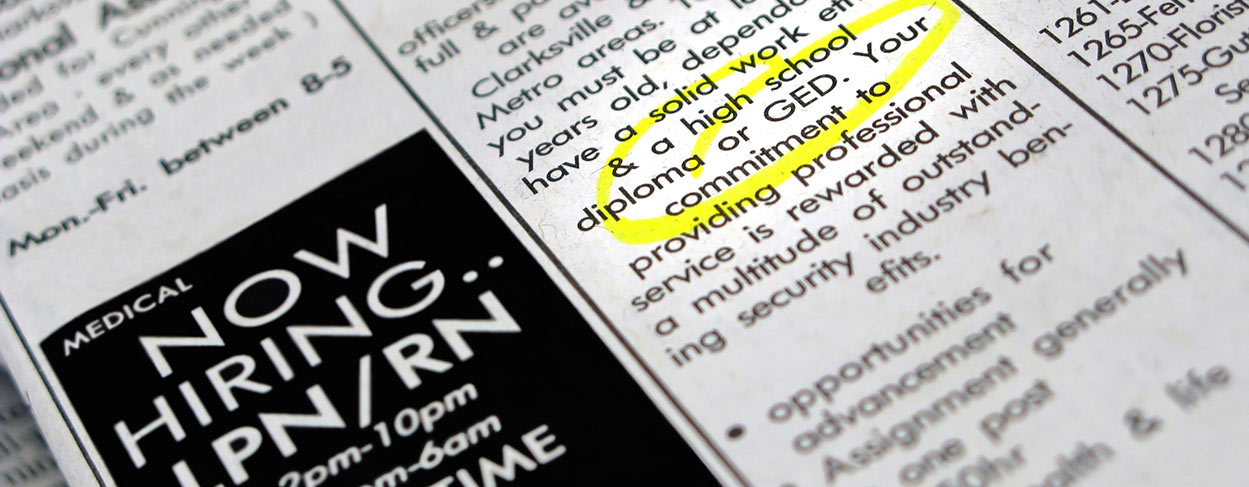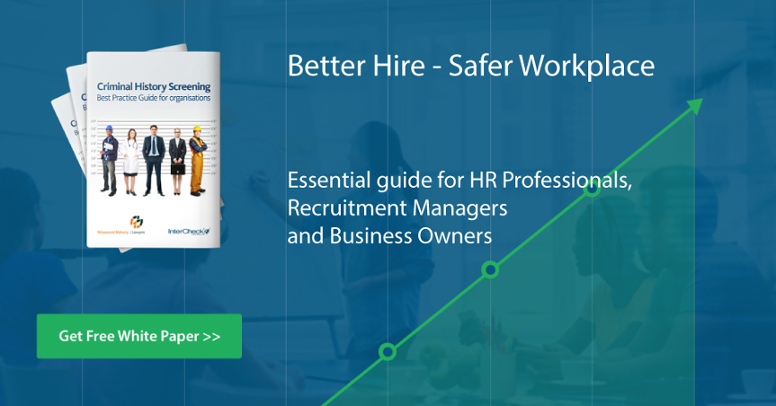
All employers, whether they work in a big or small organisation, will at some point find the need to hire a new employee. This could either be for a new role in the company or a recently vacated one. To ensure you’re equipped with hiring skills when the time comes, this guide will cover the four stages of the interview process:
The guide will not only help make the recruitment process much faster and more efficient for you
and your team, but hopefully also more enjoyable. So let’s get started.
1
Pre-interview
a) Writing the ad
Before you begin hiring employees, you’ll need to draw them in by writing and posting a job advertisement to get the word out there. Avoid wasting your time on interviewing people who don’t meet your requirements by writing an ad that will lure in suitable candidates and discourage others.
Here are some tips for writing a job advertisement that will help you attract the kind of candidate you’re after:
Job analysis
Before writing your advertisement, conduct a job analysis. Analyse the vacant role and know the essential functions and key performance criteria. When you’ve found this information, write a job description and person-specification for the position based on this analysis. The job description should accurately reflect the current job duties and responsibilities performed by the employee, or those of the would-be future employee. More information about conducting a job analysis is given later in this guide.
Headline
Attract the attention of job seekers by using a strong, interesting, and relevant headline. This could be either the job title, which can be as descriptive or creative as you like, or a catchy benefit-based promise that sets the position or opportunity apart from others.
Give details
Grab the reader’s interest from the first few paragraphs. Have a short overview that details any interesting, relevant, and important information about the job. Make sure you include the:
- Purpose,
- Responsibilities,
- Team members/department,
- Salary,
- Location,
- Working hours, and
- Contract length.
Sell the job
Sell the benefits of the job and emphasise the employee value proposition. This could be any rewards and benefits of doing the job well, the quality of the team, and the opportunity for them to use the desired skills, abilities, and knowledge. Write about the excitement and challenges of the industry and what it would be like working for your company.
Focus on the applicant
When writing the ad, think about what applicants might want to know, and why they would be applying for the job. For a more powerful advertisement, avoid using first person and refer to the audience as ‘you’. For example, ‘you will have’ instead of ‘we require’ or ‘the successful candidate will have’.
Qualifications
Include key points from the person specification, such as ‘you will have a PhD in’, ‘previous experience necessary’, or the top 4-5 essential skills required to perform the role. This is so that candidates can decide whether or not they are suitably qualified, avoiding the incidence of unsuitable applications.
If a qualification is unnecessary, then focus on job tasks and how objectives will be met. Include what you would like the new employee to achieve, and how their success will be measured.
Active words
Ensure that candidates can envision themselves doing the job by including 4-5 active words describing what they’ll need to do for the role. For example, ‘can communicate technical terms’ or ‘can teach a new computer program’.
Call to action
Use engaging words that urge job seekers to take action and hit the ‘Apply Now’ button. You can also specify how they should contact you, whether it be via email, fax, phone call, or in person. Also specify whether a cover letter or portfolio is necessary along with the resume. Encourage candidates to want to find out more about the role by leaving particular (non-essential) information out, attaching documents, or linking to external websites for more information.
Keep it brief
Most importantly, keep the ad short and concise and use simple language that is easy to read and understand. Avoid jargon, be brief and to the point, and make each word count. Ensure you use keywords such as ‘Biology Lecturer’ rather than just ‘Lecturer’, so as to increase hits and make the job appear in relevant searches.
b) Describing your ideal candidate
The ‘person-specification’ section of your job advertisement should describe your ideal candidate, detailing what you expect of them, and what you’re after. This specification can include the following attributes:
- Personality – Outgoing, detail-oriented, entrepreneurial, etc.
- Experience – 5 or 10 years’ experience in an accounting or management role.
- Education – A certificate, diploma, Bachelor’s degree, Master’s, or PhD.
- Skills – Ability to speak another language, code, or use computer programs.
To determine these attributes, you should conduct a thorough job analysis that covers the following areas:
Mental/physical tasks
Mental tasks can include judging, planning, and managing, while physical tasks can include cleaning, lifting, and welding. The percentage of time spent for each type of task should also be considered.
How the job is conducted
This looks at the methods and equipment used to get the job done, and whether any special skills are necessary, as well as the conditions under which the work is completed.
Why the job exists
The goals of the job, what part the role plays in the grander scheme of things, and how it relates to other positions in the company.
Qualifications required
Personality traits, training, knowledge, skills, and abilities.
Undertaking a job analysis and writing the person-specification is also useful in helping you determine if you require a part- or full-time employee, a permanent or temporary position, or an independent contractor to fill in the position.
c) Wading through applications
Once you’ve put your job ad online or in a newspaper and received the applications, it’s time to sort through the piles. Here are some useful ways to quickly reduce your resume pile.
Paper or digital
Decide which you’d prefer, as you’re the one who will be wading through the resumes later. If you prefer reading on paper, print the resumes and stack them together to get through them the fastest. If you’d like to read onscreen, put the resumes together in a digital folder and organise them so that you don’t confuse those that have been read with those that are yet to be.
Pick a time
Set aside a specific time for going through your resumes. This could be once a day, or twice a week for 1-2 hours at a time. Clear your schedule to focus only on reading resumes at that particular time, and let others know that you will be unavailable. This can help keep you motivated to get through them, while helping you keep track of resumes you want to consider.
Skim
If you don’t know how, learn. Spend 10 seconds or less looking at a resume before reaching a decision. You can do this by checking if the most essential applicant details fit your company’s needs:
- Location,
- Industry,
- Background,
- Job level,
- Recent experience,
- Education,
- Job turnover, and
- Skills/abilities.
Job description
Utilise the job description and list of qualifications. You can have this in front of you to help determine qualified candidates and eliminate unqualified ones much faster.
Consistency
Keep an eye out for overall neatness and consistency in resumes. No typos, consistent formatting, and a neat layout can show attention to detail and professionalism. Also look at trends and timing in work history, education, and volunteer experiences – this should be consistent.
Separate resumes
Keep chronological and functional resumes separately. Chronological resumes list previous jobs by date, while functional resumes list key functions and achievements that aren’t connected to the job listed on the resume. With functional resumes, it’s harder to identify employment gaps and the true nature and scope of a candidate’s experience. It’s best to keep them separate and look through those later with careful attention.
Accomplishments
Look out for accomplishments that demonstrate things a candidate has actually achieved, e.g. ‘increase company sales by 50%’. A candidate who emphasises their accomplishments shows that they’re an achiever, and understand how everyday tasks affect the bottom line.
Detect a career path
Job promotions and advancement show that a candidate has a good focus and stability. For those who are only just starting out in their careers, look for any extracurricular activities and the language they use to explain their previous job positions.
Pick three criteria
Choosing the three most important pieces of criteria can help you quickly sort through the piles, while simultaneously filtering out candidates that may be unsuitable. Ideas could include looking for a degree, job stability, and a well-formatted resume as the three main criteria.
Skip cover letters
At least for now. Firstly, you’ll just be looking for the basics when sorting through the resumes. This will help narrow down the pool of qualified applicants. Secondly, you don’t want to waste time reading cover letters that turn out to be from unsuitable applicants.
Buckets
Sort your resumes into buckets. Put those that meet the three criteria in one bucket, and the rest in another. If the number of acceptable applicants or interview candidates is small, look through the other resumes for those who meet two of your criteria. Do this every time you sort through resumes, while the information is still fresh in your mind.
Keywords
Keep an eye out for keywords when reviewing online applications. Online applications are stored in a resume database, where those with certain keywords can be easily searched. This also helps identify qualified candidates.
d) Choosing candidates for interviews
After you’ve reviewed all the resumes, you should be able to choose a number of qualified candidates to interview for the position. This applies to those who fit your company’s needs, including the job description and person-specification in the job advertisement. In other words, candidates chosen for interviews should be fit for both the role and the team.
You can also determine which candidates to interview via the following two-step evaluation process:
1. Email interaction
Correspondence through email can help you analyse the candidate. You can determine things such as how interested they really are in the role by the way they respond to your emails and how they articulate themselves. If the applicant has good email interaction and responds promptly, they are a viable candidate and ready for the second step.
2. Phone screen
A brief phone interview can allow you to assess whether the candidate is both enthusiastic and articulate. It also gives you the opportunity to find out why they’re interested in the position, and from their tone of voice you can learn about whether they are being honest, nervous, confident, and so on.
2
Interview
a) Interview types
Once you’ve chosen qualified candidates for interviewing, it’s time to prepare for the face-to-face interview. But first, to ensure you choose the best candidate, you should be aware of the different types of interviews that can be conducted. There are also two other very important interviews you should know about that take place after the initial hiring process.
Interviews can be divided into three categories:
1. Screening interviews
A screening interview is used to qualify a candidate before they meet with a hiring manager or employer for possible selection. Here are some examples of screening interviews that could be conducted:
- Email interview (email interaction),
- Telephone interview (phone screening),
- Computer interview (via chat),
- Videophone or videoconferencing interview (via Skype or similar),
- Structured interview (survey).
2. Hiring/selection interviews
A hiring or selection interview is an in-person interview that takes many different forms. With this type of interview, the candidate can also ask the employer about job suitability. Here are different types of hiring/selection interviews:
- One-on-one interview,
- Serial interview,
- Sequential interview,
- Panel interview,
- Group interview,
- Situation or performance interview,
- Audition interview,
- Stress interview,
- Behavioural interview,
- Informational interview,
- Directive or structured-style interview,
- Tag-team interview,
- Meandering-style interview,
- Mealtime interview,
- Follow-up interview.
3. Post-hire interviews
A post-hire interview takes place after you’ve chosen the best candidate for the position. Here are the two types of post-hire interviews:
- Stay interview (why a new employee chooses to stay),
- Exit interview (why a new employee chooses to leave).
For more information on each interview type for screening and hiring/selection interviews, see here. You can also read more about post-hire interviews here and here. It’s important that you find the right type of interview/s that will be beneficial for both your company and potential employees.
b) Questions to ask
The next step to take is to prepare the questions you’ll ask during the hiring/selection interview in order to better gauge candidates’ level of self-awareness, compatibility, desire factor and competency based on their responses.
1. Level of self-awareness
- What is your biggest weakness?
- What was your greatest achievement at work?
- What was your greatest failure at work?
- Did you have to reinvent your job due to the changing needs of your organisation? If so, how?
- How do you continue to develop your professional skills and knowledge?
- What would your most respected critic say about your strengths, any areas for development, and your future potential in your field?
- How would your current coworkers describe you, your interactions with them, and your work performance?
- What would your current boss say about you, your work contribution, and working with you?
- How would your friends describe you?
- What makes you stand out amongst your peers?
2. Compatibility
- What experience do you have in this field?
- How many hours a day do you need to work in order to get your job done?
- Can you or can you not accept constructive criticism and why?
- Have you gotten into a conflict with a boss, professor or co-worker? How did you resolve it?
- What kind of supervision and communication would your ideal boss provide?
- Describe the pace that you normally work in the office – slow, moderate or fast?
- How much structure, direction and feedback do you usually prefer on a daily basis?
- When you make decisions, do you generally ask for permission or forgiveness?
3. Desire factor
- Why did you apply for this position?
- What challenges are you looking for in this job?
- What interested you the most about this position?
- Why do you want to leave your current employer? (if the applicant is employed)
- Why do you want to work here, and what do you know about us?
- If you were hired, what are the three most important attributes or skills that you would bring to our company?
- If you were hired, what are the first three things you would do on the job?
- How do you believe that your current skills will contribute to achieving our company’s goals and mission?
- What makes us stand out in your mind from our competitors?
- If you accepted this position today, how would you explain that to a prospective employer 5 years from now? In other words, how would this role offer a link to your future career progression?
- Why do you believe we should hire you?
- Do you have any questions to ask us?
4. Competency
- Are you an organised person?
- How did you demonstrate your organisational skills at work?
- What would you do differently next time?
- What do you believe makes a good organiser?
- Why do you think organisation skills are important?
Of course, as you conduct more interviews over time, you’ll be able to create your own list of the best questions to ask. You will know what kind of questions to ask to see whether the candidates are a good fit, how long they might stay, and how badly they want the job.
c) Behaviours/body language to watch out for
When you’re interviewing candidates, you should also look at their behaviour and body language. This can help in determining personality traits as well as giving an insight into what the candidate could be really thinking or feeling, aiding the hiring process.
Here are some behaviours/body language signs to watch out for and what they might mean:
1. The eyes
Let’s begin by looking at some warning signs to keep an ‘eye’ on. If you spot these, pay special attention to the candidate. Remember, body language should not be taken as a definite sign of how someone feels, but rather a signal to pay more attention to that person:
- Glancing to the right – If this occurs when a candidate is asking a question about themselves, it could be indicative of deception
- Dilated pupils – Dilated pupils can be a sign of betrayal, intense interest, or sexual attraction
- Excessive blinking – People blink a lot more frequently when they are put under pressure
- Prolonged eye contact – Sometimes people force prolonged eye contact when they are trying to put on a calm, collected exterior. It can also be taken as a sign of aggression
- Lack of eye contact – On the other hand, not enough eye contact could indicate insecurity, shyness, nervousness, disinterest, or dishonesty
- Squinting – This can be done when a person is carefully considering a question or topic, or could also happen when a person is frustrated or feeling distrusting
- Blank staring – This, coupled with lack of emotion, can be taken as a sign of disinterest
- Rapid eye movement – This is generally considered to be a sign of deception.
- Some positive body language signals to watch out for in the eyes include:
- Glancing to the left – Unlike the right side, this is taken to be a sign of honesty
- Comfortable eye contact – This is a good sign showing that the candidate is confident and at ease.
2. The mouth
Body language warning signs that involve the mouth area include:
- Thin-lipped smile – This is taken to be a sign of anger or rejection, particularly if the teeth are hidden
- Mouth shrug – This is a sign of denial or apathy
- Jutting bottom lip – This is typically a sign of crying, nervousness, or fear
- Lopsided smile – This is taken by some to be a sign of cynicism or sarcasm
- Mouth that moves a lot while talking – This is a sign of a dominant or overexcited nature, which may not be suitable for all roles.
Good body language signs to watch out for around the mouth include:
- Genuine laughter – Should mean that the candidate is confident and ease
- Smiling with the eyes – This also demonstrates that the candidate is feeling confident and at ease
- Smiling before making positive comment – This is taken as a sign of honesty. If the candidate smiles after the positive comment, it is generally considered to be a sign of dishonesty.
3. The lungs or breath
Warning signs to watch out for:
- Sharp intakes of breath or short breaths – Breathing shallowly or too sharply could signal that someone is feeling under pressure
- Rapid breathing – Rapid or high chest breathing shows a person is feeling at ease or trying to gain your trust by mirroring your actions.
4. The hands
Warning signs involving the hands to watch out for include:
- Tapping fingers – This shows impatience, restlessness, boredom, or disinterest in the topic and job
- Twitching, fidgeting, or sweaty palms – These are all signs of nervousness or deception
- Pointing without context – This is considered to be a sign of aggression
- Clenched fists – This could either be a sign of aggression or of anger
- Waving hands and making sharp gestures – These are taken to be a sign of aggression and unprofessionalism
- Hiding hands – This is considered to be a sign of deception
- Limp handshake – This is generally indicative of disinterest or weakness
- Painful handshake – On the other hand, this is considered a sign of dominance, aggression, and insensitivity
- Forceful handshake – This is taken by some to be a sign of overeagerness and insecurity.
Positive hand gestures to watch out for during the interview process include:
- Steepling – This is a sign of confidence, deep thought, and elevated thinking
- Hands on lap – Calmly placing hands on the lap could signal a person is feeling self-assured and relaxed
- Open hand gestures – This is a sign of openness, positivity, and sincerity
- Flipping hands over – People doing this are generally considered to be reflecting genuine thought and deliberation
- Firm handshake – This, coupled with direct eye contact and a smile, is thought to be a sign of confidence, interest, and sincerity.
5. The whole body
Warning signs involving the whole body include:
- Slouching or leaning back – This is a sign of disinterest, arrogance, or boredom, however could also indicate a lack of confidence and submission if nervous
- Leaning forward with hands on thighs This can either be a sign of confidence or of the candidate wanting to leave
- Touching their arm – This is a sign that the candidate may be comforting themselves at times the interview might not be going so well
- Crossing arms – This is a sign of confrontation, arrogance, boredom, or a negative and defensive attitude
- Resting ankle on one knee – This is a sign of arrogance and having a very casual attitude
- Swivelling in chair or distraction – This is a sign that the candidate is not taking you or the interview very seriously.
Positive body language signs to look out for include:
- Straight and neutral posture – This indicates the candidate is feeling confident and interested, and if their back is straight, they are also likely to be a high performer
- Learning forward, actively listening – This, coupled with good eye contact, is a sign of enthusiasm and interest.
d) Characteristics of a good applicant
Another thing to look out for in an interview is the applicant’s personal characteristics. These can be identified in a behavioural interview.
A good applicant will have some or all of the following personality traits
- Adaptability
- Articulateness
- Accountability
- Perseverance
- Listening skills
- High energy
- Confidence
- Integrity
- Self-direction
- Focus
- Networking skills
- Determination
- Enthusiasm
These characteristics can also help you decide which candidate is a good fit for the position and your company.
e) Quizzing through resume
During the interview process, it’s important to ask questions about the candidate’s resume as well as their personality. A typical resume should include a candidate’s professional and educational achievements, as well as any personal achievements relevant to the position. Taking a look at the candidate’s past can help you determine their future, so by asking questions from their past you can gauge what their capacities are for the future and what they might deliver. More importantly, working through the resume will give you a full grasp of the nature of work that the candidate has performed in the past.
Some questions you can ask about a candidate’s past work or educational experience include:
- Why did you choose your particular major?
- Why did you choose your particular internships? What did you learn from them? (For graduates)
- What experience do you have in this particular niche?
- What did you learn from [any job]?
- What were your responsibilities as part of the team?
- How did your involvement in the business affect the product/service?
- What are your three most important attributes or skills?
- How do you apply them at work?
- What have been your biggest failures and achievements in the workplace?
- How do you keep track of your own schedules and desk work in your current job?
- Have you had to deal with difficult customers or clients in the past? Describe your most difficult customer, the situation, and how the issue was resolved.
These characteristics can also help you decide which candidate is a good fit for the position and your company.
3
Post-interview
a) Conducting background checks
It’s also a good idea to conduct a background check prior to the evaluation process so as to ensure there is no criminal history that could change your opinion on the candidate. This is particularly important when candidates are applying for a high security role or one where they are in a position of trust. Background checks will allow you to verify a candidate’s previous employment, as well as any criminal commercial, and financial records that may exist.
A background check can be used as a means of judging a candidate’s past mistakes, character, and fitness, as well as identifying any potential hiring security risks. A background check can also confirm the information provided by the candidate on their application or resume. This again will be helpful when it comes to choosing the best candidate.
b) Evaluating employees and contacting references
A couple of weeks after completing the interviews, it’ll be time to choose the best candidate. If there was more than one person interviewing, ensure you all gather together to evaluate the employees. Go through each candidate and give all interviewers ten or fifteen minutes to share their impressions. You should then be able to choose the most suitable candidate, according to the consideration of all who were involved in the interview process. A good idea is to have the initial discussion followed by a quick vote as for who the interviewers considered the best candidate.
By this time you should have also contacted the references of qualified candidates, and should utilise any information during this evaluation process. You can ask references about the candidate’s work performance and personality to see if it’s a good fit. If your office is a fun, silly place and the candidate is no-nonsense, it might not work out. You could also ask references if the candidate’s work area was organised or messy, how they interacted with other employees, and if they participated in external activities. Your questions should be based around what’s important to you and your company’s work culture.
c) Contacting applicants
Once you’ve chosen your ideal candidate it’s time to send out those acceptance and rejection letters.
1. Accepting the application
The acceptance or job offer letter should be written and sent by the person responsible for supervising the new employee. It should include the following information:
- Conveying that you’re pleased to be offering the job to the candidate,
- Specifying the amount of compensation and benefits on offer,
- The start date,
- A signature line for the applicant to sign,
- Instructions asking them to sign a copy of the offer letter and return it by a certain date, preferably a week after considering the offer,
- A mention of any probationary periods and how long they last for,
- Contact information for any questions,
- An attachment with a copy of the job description to ensure that the offer is associated with the correct job.
Once the candidate has accepted the offer, start a personal file containing their resume, job description, job offer letter, signed and returned letter, completed tax withholding forms, signed benefit forms, and so on.
2. Rejecting the application
To those candidates to whom you won’t be extending a job offer, send a letter with the following:
- Acknowledging their strengths, skills, and abilities,
- Providing a specific reason for the rejection, e.g. insufficient experience, another candidate more closely matched the job description, etc.,
- Providing feedback that details why they weren’t selected for the job, any interview tips for them to learn from, and suggestions on how they can improve their skills,
- Notifying them if you will keep their application on file so that they know they could be considered for new roles in the company.
For internal candidates who already work for your company, give them the rejection letter in person so as to not to demoralise them and also provide feedback on how they could become a stronger candidate in the future.
Sources
- http://hr.anu.edu.au/employment-at-anu/recruitment-toolkit/preparing-the-advertisement/effective-advertisements
- http://hr.leeds.ac.uk/info/21/advertising/149/writing_the_job_advert
- https://www.workcabin.ca/articles/hr-articles/how-write-effective-job-ad-0
- http://www.entrepreneur.com/article/56394
- http://www.entrepreneur.com/article/56490
- http://www.shrm.org/templatestools/hrqa/pages/conductjobanalysis.aspx
- http://www.hrbartender.com/2011/recruiting/what-hr-wont-tell-you-about-online-applications/
- https://www.ziprecruiter.com/blog/how-to-sort-through-resumes/
- http://www.inc.com/minda-zetlin/7-secrets-to-speed-through-a-pile-of-resumes.html
- https://www.go2hr.ca/articles/how-effectively-screen-resumes
- http://www.impacthiringsolutions.com/careerblog/2010/01/18/how-recruiters-read-resumes-in-10-seconds-or-less/
- http://www.hireology.com/blog/bid/98549/The-Do-s-And-Dont-s-To-Get-Through-A-Resume-Pile
- http://smallbusiness.findlaw.com/employment-law-and-human-resources/the-interview-process-selecting-the-right-person.html
- http://boss.blogs.nytimes.com/2013/03/05/you-have-identified-the-candidates-how-do-you-pick-the-right-one/?_r=0
- http://www.hongkiat.com/blog/choosing-the-right-candidate/
- https://www.themuse.com/advice/beyond-the-resume-how-to-choose-the-best-candidates
- http://smallbusiness.findlaw.com/employment-law-and-human-resources/the-interview-process-selecting-the-right-person.html
- http://humanresources.about.com/cs/selectionstaffing/a/interviews.htm
- http://humanresources.about.com/od/interviewing/a/behavior_interv.htm
- http://www.slideshare.net/williamsjodie123/top-10-human-resources-interview-questions-with-answers
- http://www.careers.ox.ac.uk/the-application-process/interviews/types-of-questions/
- http://humanresources.about.com/od/interview-questions/a/best-interview-questions-to-ask.htm
- http://hiring.monster.com/hr/hr-best-practices/small-business/conducting-an-interview/interviewing-job-candidates.aspx
- http://www.coburgbanks.co.uk/blog/assessing-applicants/20-body-language-warning-signs-to-watch-out-for-when-interviewing-candidates
- http://hiring.monster.com/hr/hr-best-practices/recruiting-hiring-advice/interviewing-candidates/interview-body-language.aspx
- https://www.smartrecruiters.com/blog/how-to-assess-interview-body-language/
- http://smallbusiness.chron.com/say-applicant-after-phone-interview-39263.html
- http://www.eliastorres.com/blog/dont-ruin-your-reputation
- http://managementhelp.org/staffing/hiring.htm
- http://quickbase.intuit.com/blog/2012/08/02/how-to-reject-job-candidates/’











